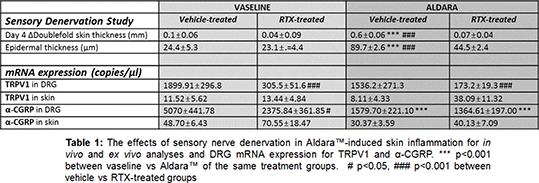| 161P London, UK Pharmacology 2016 |
The protective role of sensory denervation in aldara™-induced skin inflammation is independent of trpv1 and α-cgrp expression
Introduction: Psoriasis, a common chronic skin inflammation, affects 2-3% of the UK population (1). Using a murine model of psoriasis (2), this study aimed to elucidate whether TRPV1 and α-CGRP is involved in the protective role of sensory denervation in this model (3,4).
Methods: All in vivo procedures were carried out in accordance to the UK Home Office Animals (Scientific Procedures) Act 1986. Male WT C57BL/6J (n=6-7 per group; 6-8 weeks), TRPV1 KO (n=5-7 per group;6-8 weeks), or α-CGRP KO (n=6-7 per group; 6-8 weeks) mice were anaesthetised using 2% isoflurane for in vivo analyses. Data were analysed using 2-way or repeated measures ANOVA with Bonferonni’s post-hoc test. After dorsal skin hair removal, 75mg of Aldara™ (5% imiquimod) cream (Meda Pharma, UK) or Vaseline (for control) was applied over a 2x2cm2 area daily for 4 days. Aldara treatment resulted in significant increase in skin thickness (Table 1).
Results: Previously, we have shown that sensory denervation resulted in reduced skin inflammation (4). Sensory denervation significantly reduced both TRPV1 and α-CGRP mRNA expression in the dorsal root ganglia (DRG). TRPV1 mRNA expression did not change regardless of skin treatment, while α-CGRP mRNA was reduced with Aldara treatment (Table 1). However, in vivo study in TRPV1 KO and α-CGRP KO failed to show significant differences in terms of various in vivo and ex vivo parameters, including skin thickness, blood flow and spleen weight (Table 2).


Conclusions: We provide evidence that the beneficial effects of sensory nerve depletion in Aldara™-induced skin inflammation is independent of TRPV1 and α-CGRP expression.
References:
1. Nestle FO (2009). New Eng J Med 361: 496-509
2. Van der Fits L et al. (2009). J Immunol 182: 5836-5845
3. Riol-Blanco L et al. (2014). Nature 510: 157-1614.
4. Kodji X et al. (2015) pA2 Online

